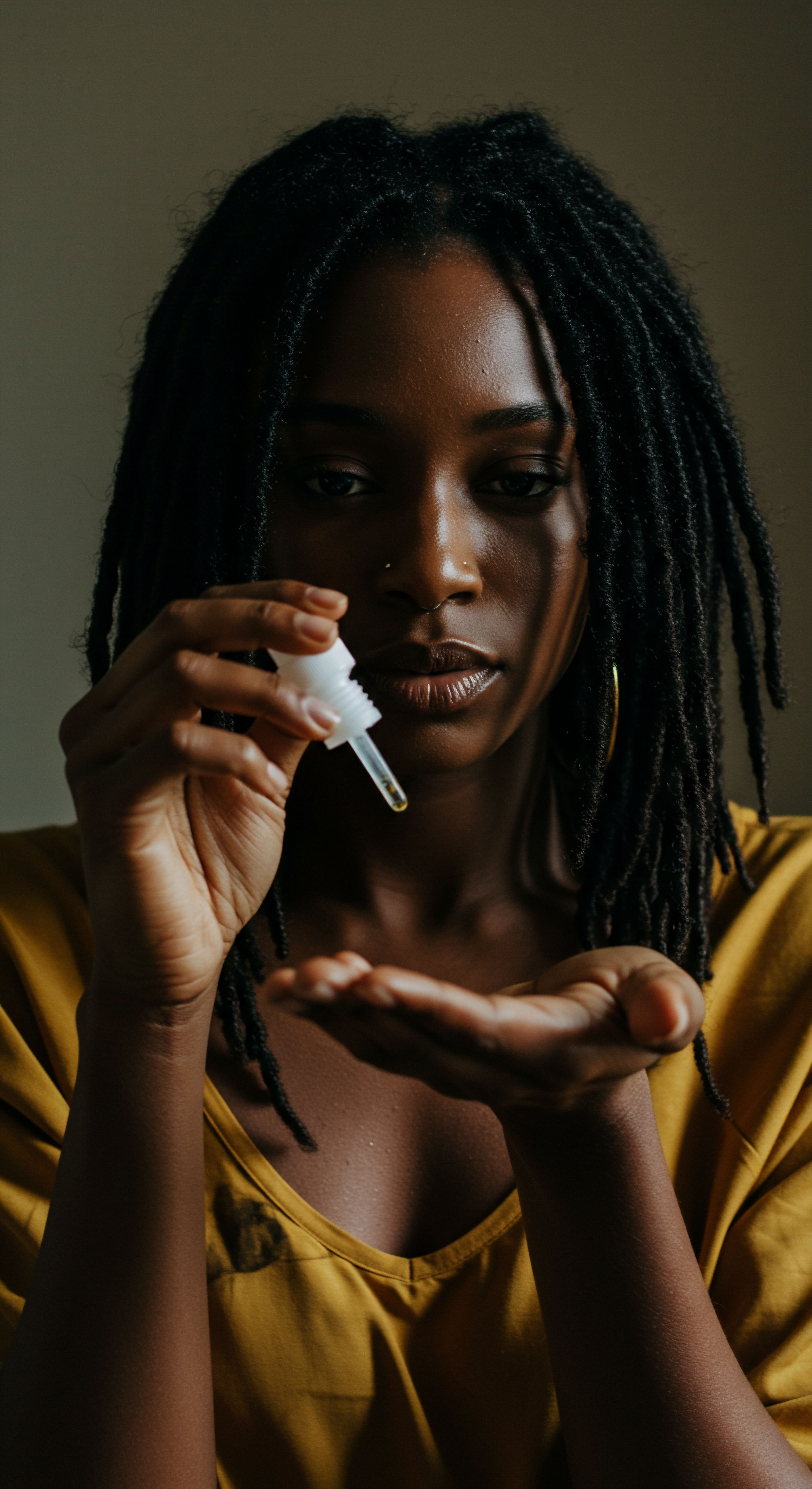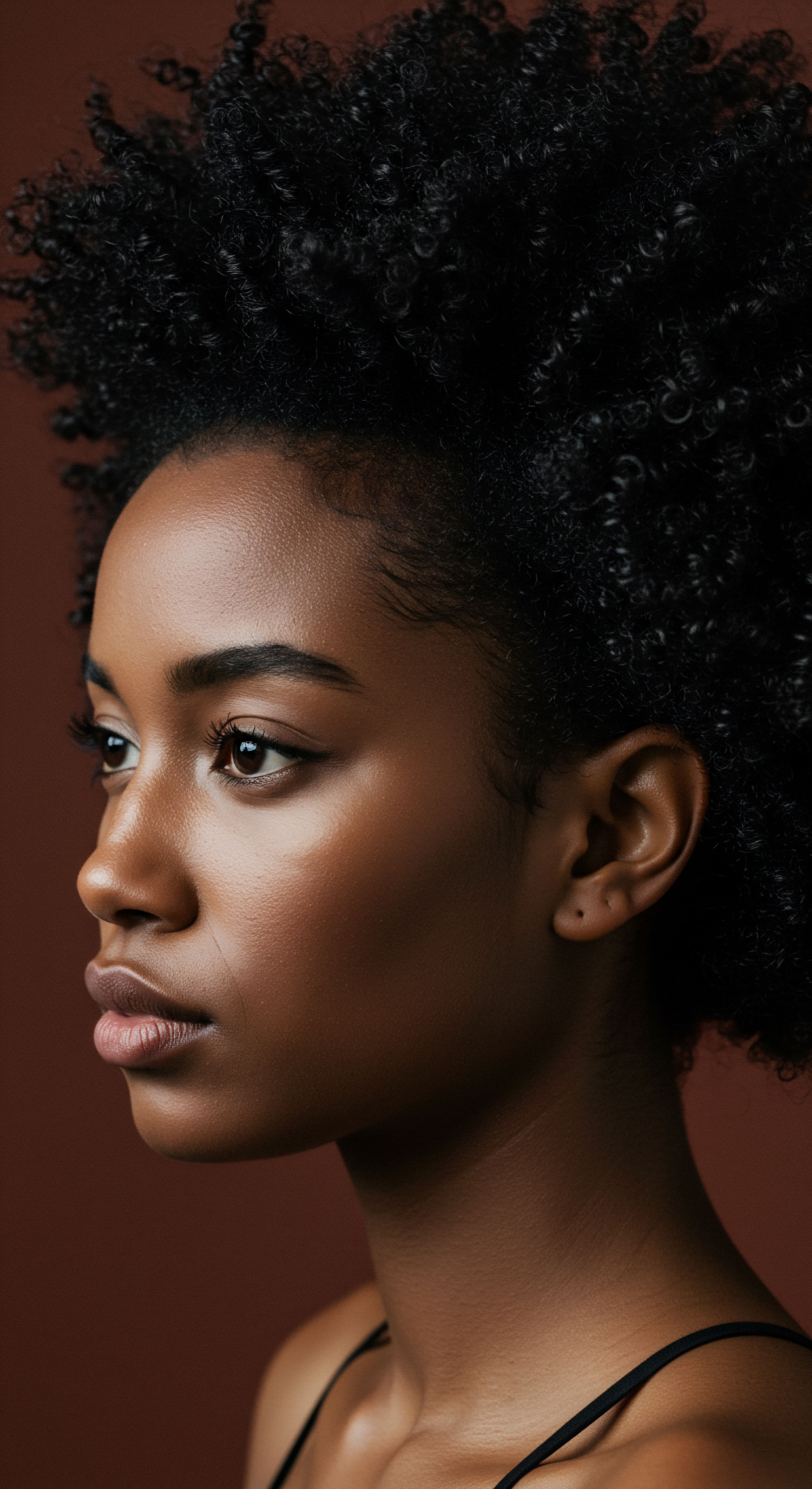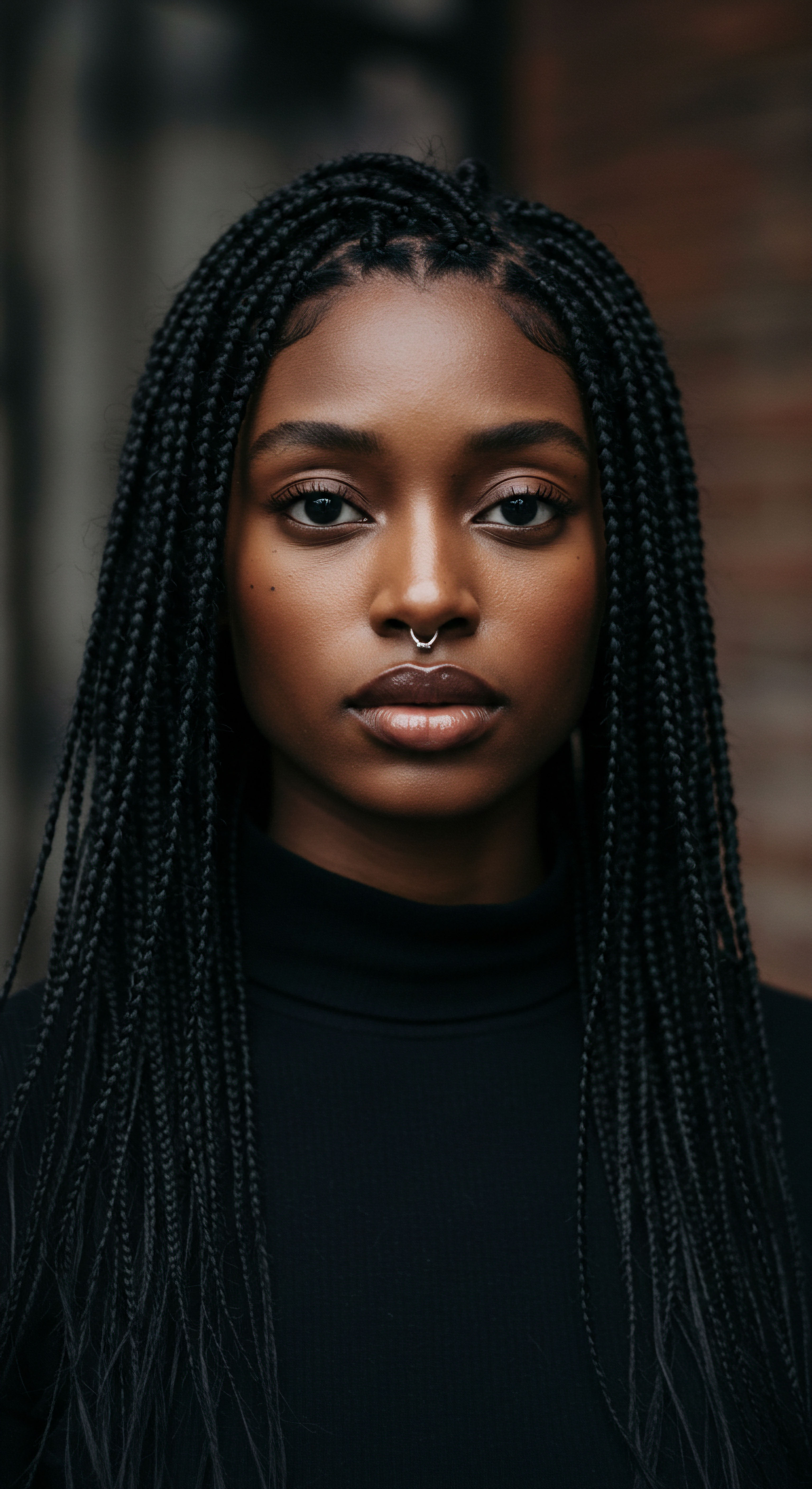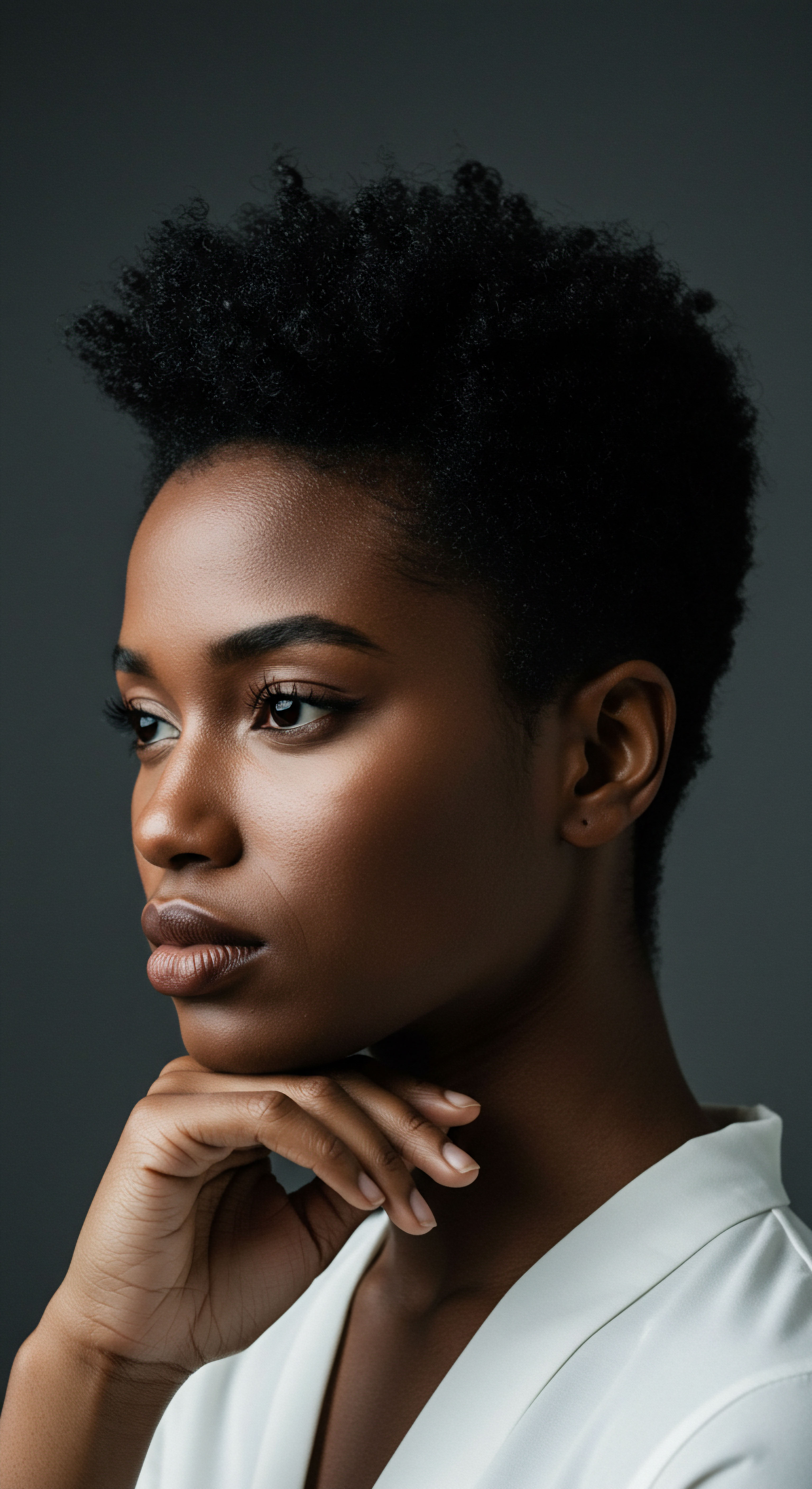
Roots
The quiet moments before sleep hold a profound significance for the coiled and textured hair. It is during these hours, when the world settles into its slumber, that the very essence of a curl’s definition, its resilience, and its inherent glow are either preserved or diminished. This nightly period is not merely about preventing tangles or maintaining a style; it represents a deep interaction between biological reality, ancestral wisdom, and the deliberate choices made for care. Understanding how the structure of textured hair responds to its nightly environment unveils a hidden conversation, a silent shaping that dictates how curls greet the morning light.

Anatomy and Physiology of Coiled Hair
At its core, the texture of hair, particularly that which forms spirals and coils, possesses a distinct anatomical blueprint. Unlike straight strands that emerge from round follicles, curly and coily hair grows from oval-shaped follicles, causing the hair shaft to bend and twist as it ascends. This helical structure means natural oils produced by the scalp, known as sebum, struggle to travel down the entire length of the strand.
The result is often a predisposition to dryness, especially at the ends, which are the oldest and most exposed parts of the hair. Each bend in a curl also represents a potential point of weakness, a place where the cuticle, the hair’s protective outer layer, can lift and become vulnerable to external forces.
The cuticle itself, composed of overlapping scales, functions as the hair’s armor. When these scales lie flat, the hair appears smooth, reflects light, and retains moisture effectively. When they are raised, whether from dryness, damage, or friction, moisture escapes, and the hair becomes susceptible to frizz and breakage. Nightly practices, or the lack thereof, play a significant role in determining the state of this protective cuticle.
A hair strand’s ability to retain water, known as its Porosity, is also a critical factor. High porosity hair, with its more open cuticles, readily absorbs moisture but also loses it just as quickly. Low porosity hair, with tightly bound cuticles, resists moisture penetration but holds onto it once absorbed. Nighttime routines must consider these unique characteristics to optimize hydration and structural integrity.

The Classification of Textured Hair
The broad spectrum of textured hair is often categorized into types, from wavy (Type 2) to tightly coiled (Type 4), with further subdivisions based on the curl’s diameter and density. While these classifications offer a common language, they also highlight the diverse needs within the textured hair community. A looser wave may experience different challenges overnight than a tightly coiled strand.
For instance, Type 2 and 3 curls might face flattening or loss of definition, while Type 4 coils might contend more with shrinkage, dryness, and tangling. Each curl type presents a unique challenge to the nocturnal environment, requiring tailored consideration to preserve its intrinsic form and health.
Understanding these categories helps in selecting appropriate protective measures. A simple pineapple method might suffice for some Type 3 curls, while Type 4 coils may demand more encompassing protection like multiple braids or twists, securely contained within a bonnet. The individual nature of each head of hair means that even within a single classification, responses to nightly care can vary, underscoring the importance of attentive observation and personalized adaptation.

The Essential Language of Textured Hair
To truly understand the dialogue between curls and their nightly environment, one must speak the language of textured hair. Terms like Frizz, Breakage, Shrinkage, and Definition are not merely descriptors; they are indicators of hair health and the efficacy of care practices. Frizz, often the result of lifted cuticles seeking moisture from the humid air, becomes a nocturnal battleground. Breakage, the snapping of hair strands, frequently occurs due to friction against abrasive surfaces during sleep.
Shrinkage, the apparent reduction in hair length as curls dry and contract, can be exacerbated or mitigated by how hair is prepared for rest. Definition, the crispness and separation of individual curl clumps, is a prized quality that nightly routines aim to preserve.
Other vital terms include Moisture Balance, the delicate equilibrium of water within the hair shaft; Protective Styling, methods used to shield hair from manipulation and environmental stressors; and Slip, the ease with which products allow strands to glide past one another, reducing friction. These terms, when understood deeply, provide a framework for discussing and addressing the specific impacts of nighttime practices on the texture of curls, allowing for a more precise and effective approach to care.
The nocturnal period significantly shapes a curl’s texture, resilience, and definition, making informed nightly care a silent, yet powerful, determinant of morning hair health.

Hair Growth Cycles and Influencing Factors
The hair growth cycle consists of three main phases ❉ anagen (growth), catagen (transition), and telogen (resting). While nightly practices do not directly alter these inherent biological rhythms, they profoundly influence the health of the hair as it progresses through these stages. Optimal conditions during sleep support the anagen phase by minimizing stressors that could prematurely push hair into the telogen phase, leading to shedding.
Conversely, friction, dryness, or tension applied overnight can weaken strands, causing breakage that might be mistaken for hair loss, but is in fact mechanical damage to existing hair. Studies suggest that sleep deprivation itself can influence hormonal balances and stress levels, which in turn can impact the hair growth cycle and contribute to conditions like telogen effluvium, a temporary form of hair loss characterized by excessive shedding.
For example, research indicates that Circadian Rhythm Disruptions, as observed in shift workers, can lead to decreased stem cell activity in hair follicles, potentially resulting in thinner, weaker hair over time. This connection between the body’s natural rhythms and hair follicle health underscores the importance of a consistent, protective nightly routine, not only for the visible curl but for the underlying biological processes that sustain it. Maintaining a calm, restorative sleep environment thus extends beyond aesthetics, touching upon the very vitality of hair from its roots.

Ritual
As daylight fades and the world prepares for rest, those with textured hair embark upon a series of deliberate actions, a nightly ritual designed to preserve the delicate structure of their curls. This is a time of gentle preparation, a thoughtful transition from the day’s encounters to the restorative hours of sleep. It is a moment where the practical wisdom of generations meets modern understanding, creating a personal ceremony that shields and nurtures. The impact of these practices on the texture of curls is not merely anecdotal; it is a demonstrable dance between friction, moisture, and careful positioning, all conspiring to shape the curl’s morning disposition.

Protecting Curls Overnight
The primary adversary to curl integrity during sleep is friction. The constant rubbing of hair against abrasive surfaces, like cotton pillowcases, can rough up the cuticle, leading to frizz, tangles, and breakage. This mechanical stress can undo hours of careful styling and hydration. The solution often lies in creating a smooth, low-friction environment.
Silk and Satin Pillowcases are often recommended for this purpose, as their smooth surfaces allow hair to glide rather than snag. Studies, while sometimes limited in rigorous clinical trials, consistently point to reduced frizz and tangling with the use of these materials.
Beyond surface protection, enclosing the hair offers an additional layer of defense. Bonnets, scarves, and wraps, traditionally made from silk or satin, encase the curls, keeping them contained and minimizing movement against external surfaces or even against other hair strands. This containment is particularly beneficial for preserving definition and preventing the formation of matted areas. The historical significance of hair wrapping across various cultures, from African traditions to Japanese geishas, speaks to a long-held understanding of its protective power.
For example, the practice of hair wrapping has deep roots in African and Afro-Caribbean cultures, where head wraps or ties have been used for centuries to shield curly hair from damage and breakage during the night. This tradition is not solely about physical preservation; it also carries profound cultural significance, symbolizing pride, identity, and a connection to ancestral practices.
| Tool Silk Pillowcase |
| Primary Benefit Reduces friction, retains moisture |
| Ideal Curl Types All, especially prone to frizz/tangles |
| Tool Satin Bonnet |
| Primary Benefit Encases hair, minimizes friction, preserves style |
| Ideal Curl Types All, particularly coils and tighter curls |
| Tool Silk Scarf |
| Primary Benefit Versatile wrapping, style preservation, moisture retention |
| Ideal Curl Types All, offers customizable protection |
| Tool Loose Scrunchie |
| Primary Benefit Holds hair gently without creasing |
| Ideal Curl Types Wavy to curly (Type 2-3) for pineappling |
| Tool Selecting the appropriate tool depends on individual hair needs and desired morning outcome. |

Nighttime Styling Techniques
The way curls are positioned before sleep profoundly impacts their texture upon waking. Several techniques aim to maintain curl pattern, prevent stretching, and encourage volume. The Pineapple Method involves gathering all hair loosely at the very top of the head, creating a high, loose ponytail or bun.
This allows the curls to fall forward, minimizing crushing against the pillow and preserving root volume. It is a widely used method for maintaining curl definition and can be particularly effective for looser curl patterns.
For tighter coils and those seeking to elongate their curl pattern, Braids or Twists offer a more structured approach. Dividing the hair into several sections and creating loose braids or two-strand twists can prevent tangling and excessive shrinkage. This method also provides a gentle stretch, which can be beneficial for reducing morning frizz and maintaining length.
The number and tightness of the braids or twists can be adjusted based on the desired outcome—fewer, looser braids for a more relaxed wave, and more numerous, tighter twists for increased definition. The historical practice of braiding hair before sleep is also documented in various cultures, often paired with hair oiling rituals to further protect and nourish the strands.
Thoughtful nighttime preparation, using low-friction materials and protective styles, shields curls from damage and helps preserve their intrinsic texture and definition.
Another technique involves Bantu Knots, where sections of hair are twisted and coiled into small knots against the scalp. This method is particularly effective for very tight coils, offering maximum protection and producing highly defined, springy curls when unraveled. For those with looser curls, a loose low bun can serve a similar purpose, minimizing friction at the nape of the neck while keeping strands contained. Each technique serves to reduce mechanical stress and preserve the hair’s natural moisture, contributing to a more vibrant and defined curl pattern come morning.

Moisture Preservation and Product Application
As textured hair is prone to dryness, maintaining moisture overnight is paramount. Before styling, many opt to lightly mist their curls with water or a hydrating leave-in conditioner. This reintroduces a small amount of moisture, making the hair more pliable for protective styling and helping to seal the cuticle. Following this, a lightweight curl cream, hydrating serum, or a few drops of a beneficial oil can be applied.
These products work to lock in moisture, provide slip to reduce friction between strands, and offer a soft hold that helps curls retain their shape without feeling stiff. Oils like jojoba, argan, or coconut are popular choices for their conditioning properties and ability to form a protective barrier.
The choice of products also depends on hair porosity. For high porosity hair, which loses moisture quickly, heavier creams and oils may be more effective in sealing the cuticle. For low porosity hair, which resists moisture, lighter lotions or milk-based products applied to damp hair might work better to avoid product buildup, which can weigh down curls. Some studies suggest that pre-shampoo treatments can significantly improve moisture retention and reduce damage in low porosity hair, indicating that even pre-sleep preparation can extend to the next wash day.
Beyond topical applications, the ambient humidity of the sleeping environment can play a role. A humidifier in the bedroom can help maintain moisture in the air, preventing hair from becoming overly dry or brittle overnight. This subtle environmental adjustment supports the hair’s natural hydration, reducing the need for excessive product application and allowing curls to retain their softness and spring.

Relay
To truly comprehend the intricate dance between nightly hair care and the very texture of curls, one must look beyond surface-level observations and delve into the scientific underpinnings, the cultural legacies, and the often-unseen psychological dimensions. This exploration transcends simple cause and effect, revealing a complex interplay where biological mechanisms meet deeply ingrained human practices. The way we attend to our hair before sleep is not merely a routine; it is a conversation with our cellular structure, a nod to collective memory, and a quiet act of self-preservation that shapes not only our appearance but our sense of self.

How Does Sleep Impact Hair at a Microscopic Level?
The hours spent in slumber are far from static for our hair. At a microscopic level, the hair shaft, particularly its outermost cuticle layer, undergoes constant interaction with its environment. During sleep, mechanical friction against pillowcases, bedding, or even other strands of hair can cause the delicate cuticle scales to lift, leading to increased porosity and a roughened surface.
This is particularly true for cotton pillowcases, whose absorbent fibers can also draw moisture away from the hair. When the cuticle is compromised, the inner cortex, responsible for the hair’s strength and elasticity, becomes exposed, making the strand more vulnerable to breakage and damage.
The impact of sleep on hair extends beyond mere friction. The body’s physiological processes during sleep, such as blood circulation and hormonal regulation, also play a role. Adequate sleep supports optimal blood flow to the scalp, delivering essential nutrients to hair follicles, which are the very factories of hair growth. Disruptions in sleep patterns can affect hormone production, including melatonin, which has been shown to influence hair follicle regulation.
A 2017 study on facial skin revealed a significant decrease in skin hydration and impaired barrier function after just one night of sleep deprivation, indicating that the body’s ability to maintain moisture and integrity is compromised without sufficient rest. While this study focused on skin, the principles of hydration and barrier function extend to the scalp and hair, suggesting a similar vulnerability.
Consider the delicate balance of Transepidermal Water Loss (TEWL). During sleep, if the hair is not adequately protected, water can evaporate from the strands more readily, contributing to dryness. This phenomenon is particularly pronounced in textured hair due to its naturally higher porosity and the tortuous path natural oils must travel. Thus, nightly practices that minimize TEWL, such as sealing the hair with oils or creams and covering it, are not just about aesthetics; they are about maintaining the hair’s internal moisture equilibrium, which directly influences its flexibility and resistance to damage.

What Role Do Cultural Practices Play in Nightly Hair Protection?
The act of preparing hair for sleep is deeply rooted in cultural practices, especially within communities with textured hair. For centuries, across various African, Asian, and indigenous cultures, head coverings and specific styling techniques have been passed down through generations, not only for aesthetic reasons but for practical preservation and cultural continuity. These practices were often born out of necessity—to protect hair from environmental elements, maintain elaborate styles, and prevent damage during sleep without access to modern conditioning agents or styling tools.
The use of bonnets and scarves, now increasingly mainstream, has a rich and complex history. In many Black communities, the bonnet is a fundamental tool for protecting curls and coils, minimizing friction, and preserving moisture overnight. Its adoption was often a practical response to the unique needs of textured hair, which is prone to dryness and breakage.
Historically, head wraps also served as powerful symbols of identity, status, and even resistance, particularly during periods of oppression where laws attempted to diminish Black women’s beauty by mandating head coverings. Yet, these women transformed the mandate into an act of defiant beauty, using ornate fabrics and intricate tying styles.
Beyond bonnets, traditional methods like oiling and braiding before sleep are seen in South Asian cultures. The Ayurvedic practice of applying warm herbal oils to the scalp and hair, often left overnight, aims to nourish, strengthen, and improve circulation. These practices are not just about hair health; they are communal rituals, acts of care passed from mothers to daughters, fostering connection and cultural identity. The significance of these traditions underscores that hair care is never solely a physical act; it is a conduit for heritage, a shared language of care that extends across time and geography.

How Does Nightly Hair Care Connect to Psychological Well-Being?
The relationship between hair and self-perception is profound, and nightly hair care rituals contribute significantly to psychological well-being. For many, hair is a potent symbol of identity, self-expression, and confidence. Waking up to well-maintained, defined curls can set a positive tone for the day, boosting self-esteem and contributing to a sense of readiness to face the world. Conversely, waking to tangled, frizzy, or flattened hair can lead to frustration, self-consciousness, and a perceived “bad hair day,” which social psychology research suggests can indeed impact one’s attitude and interactions.
The very act of engaging in a nightly hair care ritual can serve as a form of self-care, a quiet moment of attention dedicated to oneself. This deliberate pause can help reduce stress and promote relaxation, transforming a functional task into a therapeutic experience. For Black women, in particular, the nightly ritual of hair wrapping often extends beyond physical protection; it becomes an act of prioritizing self-care in the face of daily stressors and historical scrutiny. This ritual can provide a sense of peace and aid in obtaining restful sleep, which itself is critical for overall health and hair vitality.
Microscopic interactions during sleep, cultural practices of hair protection, and the psychological impact of morning curl appearance collectively reveal the profound, multi-dimensional influence of nightly hair care.
Moreover, the communal aspect of learning and performing these rituals, often passed down through family, reinforces a sense of belonging and connection. This intergenerational transfer of knowledge instills not only practical skills but also a deeper appreciation for one’s heritage and the significance of hair as a marker of cultural identity. Thus, nightly hair care is not simply about preventing physical damage; it is about reinforcing self-worth, managing daily anxieties, and honoring a rich cultural legacy, all of which contribute to the holistic health of the individual and the vibrant texture of their curls.

Reflection
As the final whispers of the day settle, and the quiet promise of tomorrow hovers, the intricate dance of nightly hair care for textured curls reveals itself as far more than a mere routine. It is a dialogue between the individual and their heritage, a testament to the resilience of natural form, and a profound act of self-care that echoes through generations. Each strand, each coil, carries not only its genetic blueprint but the story of how it has been tended, protected, and celebrated through the night.
The gentle placement of a bonnet, the thoughtful twist of a braid, the deliberate application of a nourishing balm—these are not just steps; they are expressions of reverence for a unique beauty that deserves to greet the dawn with its full, uncompromised vibrancy. The texture of curls, then, is not simply a matter of biology; it is a living chronicle, shaped by the mindful quiet of the night, ready to unfold its splendor with the morning light.

References
- Hata, A. (1987). Studies on low molecular weight hydrolyzed sericin as an excellent hair conditioner. Journal of the Society of Cosmetic Chemists of Japan, 21(3), 167-172.
- Engel, R. & Hoppe, U. (1988). The presence of sericin and pelargonic acid in a shampoo aids in hair washing. Journal of the Society of Cosmetic Chemists of Japan, 22(1), 35-40.
- Yamada, M. et al. (2001). Moisturizing property of a lotion containing 1% sericin and 4% D-glucose. Journal of the Society of Cosmetic Chemists of Japan, 35(4), 289-294.
- Padamwar, M. N. et al. (2005). Moisturizing properties of sericin. Journal of Cosmetic Science, 56(6), 373-382.
- Al-Nuaimi, Y. et al. (2010). Human hair follicles have a functional biological clock that is influenced by circadian rhythm. Journal of Investigative Dermatology, 130(4), 1024-1033.
- Hardman, J. A. et al. (2015). Circadian clock genes control human hair follicle pigmentation. Journal of Investigative Dermatology, 135(5), 1435-1439.
- Kwon, O. S. et al. (2015). The effects of sleep deprivation on the biophysical properties of facial skin. Journal of Cosmetic Science, 66(1), 1-10.
- Johnson, D. A. et al. (2021). Sleep health disparities and their impact on chronic diseases among Black women. Sleep Medicine Reviews, 59, 101489.
- McMichael, A. J. (2003). Hair and scalp diseases in ethnic populations. Dermatologic Clinics, 21(4), 629-644.
- Dawber, R. P. R. & Van Neste, D. (2004). Hair and Scalp Disorders ❉ Common Problems and Their Management. Blackwell Science.
- Robbins, C. R. (2012). Chemical and Physical Behavior of Human Hair (5th ed.). Springer.
- Franbourg, A. et al. (2003). Hair keratin structure ❉ A review of the various components and their interactions. Journal of Cosmetic Science, 54(4), 379-391.
- Marsh, J. M. & Johnson, A. (2019). The Science of Hair Care ❉ A Comprehensive Guide to Healthy Hair. Beauty Press.
- Molefe, N. & Ndlovu, S. (2018). African Hair ❉ Its History, Culture, and Care. Ubuntu Publishing.
- Wallace, J. A. & Singh, R. (2020). Textured Hair ❉ A Practical Guide to Care and Styling. Curl Publications.